Healthy and full of flavor, this dashi-infused Steamed Vegetables with Miso Sesame Sauce is the quickest way to get vegetables on your plates. Served with an umami-packed dipping sauce, you will want to eat another serving!
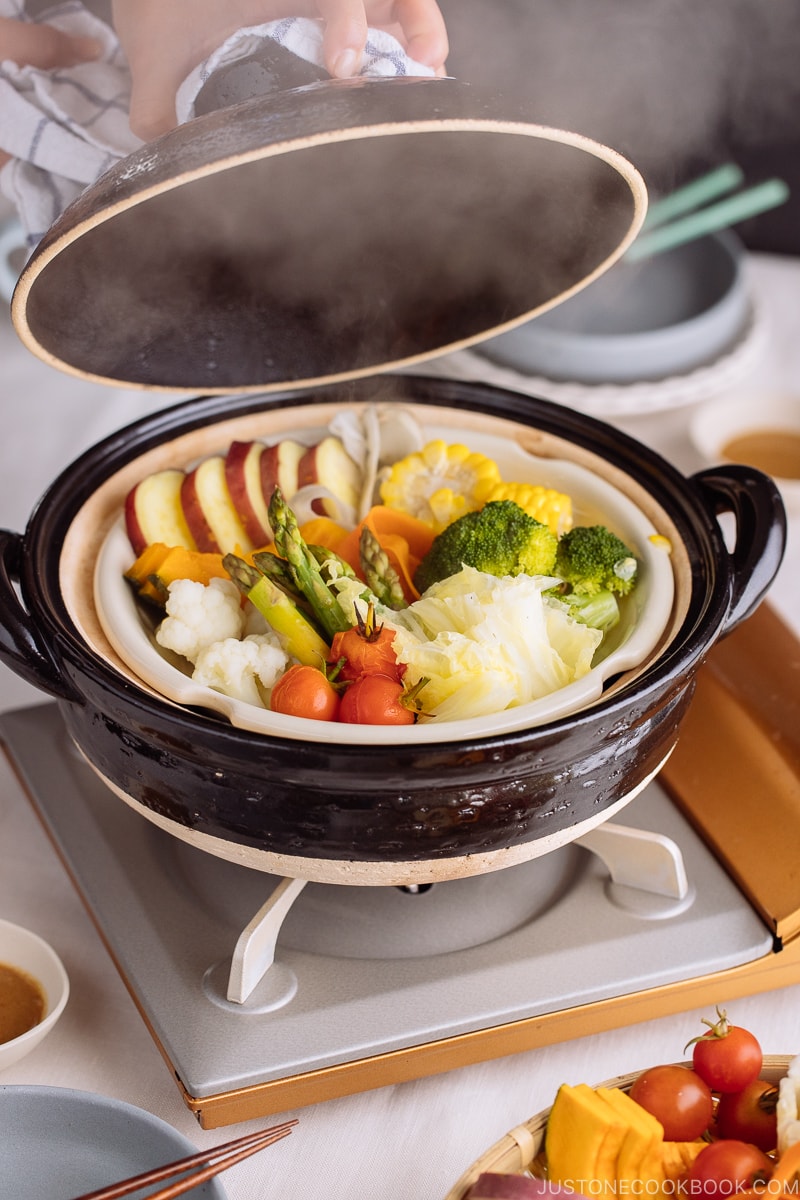
How do you eat your vegetables every day? Do you eat it as a salad, stir fry, roasted or steamed, or try to avoid it altogether? Today’s recipe will convince you to eat more of them. You’ll learn how to steam vegetables correctly and whisk together the most delicious miso sesame sauce that makes everything taste even better.
The prep requires little effort that you can steam the veggies while you’re working on other dishes. Sounds great for a weeknight meal, isn’t it? Let’s get started.

How to Steam Vegetables Perfectly Every Time
Steaming vegetables is one of the best ways to cook vegetables as steam cooking helps to preserve all the important nutrients and fiber of the vegetables. However, they can be easily overcooked. When the vegetables are over-cooked and mushy, they lose their texture and colors which can be unappetizing.
How do we avoid that? I’m here to guide you on how to perfectly steam any vegetable in a few easy steps.
1. Steam vegetables in stages based on their texture
Texturally speaking, we can group the vegetables into two types: tender vs hard. The harder and denser vegetables require a longer cooking time, while tender vegetables cook a lot faster, so it’s always important to cook them at stages. When you’re steaming vegetables, start with root vegetables such as sweet potato and carrot first, and after several minutes, you can add in tender vegetables like broccoli and zucchini into the basket.
2. Cut vegetables into uniform sizes
Each vegetable, whether hard or tender, requires the same amount of time to steam. To achieve the perfect crisp-tender texture, you need to cut them into uniform sizes so they cook roughly at the same rate.
One trick to shorten the overall steaming time is to cut the hard vegetables slightly smaller or thinner so that they cook faster.
3. Stop steaming slightly earlier
I also like to take vegetables out of the steamer when they are still a little bit crunchy. The residual heat will cook the vegetables slightly more so you don’t have to steam the vegetables until completely done. By the time you sit at the table, they might be gone mushy.

How Long to Steam Vegetables
Here’s a quick guide on steaming times for vegetables.
- Asparagus: 5-8 minutes
- Broccoli: 3-5 minutes (florets) 7 minutes (stems)
- Cabbage: 3-5 minutes
- Carrots: 8-13 minutes
- Corn on cob (1-2 inches): 8-10 minutes
- Cauliflower: 3-5 minutes (florets), 7 minutes (stem)
- Gobo slices: 5-10 minutes
- Green beans: 4-6 minutes
- Kabocha: 10-15 minutes
- Potatoes: 10-15 minutes
- Spinach: 2-3 minutes
- Sweet potatoes: 10-15 minutes
- Zucchini: 5-8 minutes
If you want to cook several kinds of vegetables in a batch, here’s an easier method that I follow:
- Leafy veggies: 2-3 minutes
- Mushrooms: 3-5 minutes
- “Fruit” vegetables (corn, cucumber, eggplant, pumpkin, zucchini, etc): 5-8 minutes
- Root vegetables: 8-10 minutes
- Potatoes and sweet potatoes: 10-15 minutes.
I usually adjust the steaming time based on how I cut the vegetables (slices vs. peels – see my recipe for gobo and carrot) and how big/small I cut them.

Make Miso Sesame Sauce for Steamed Vegetables
Steamed vegetables are absolutely wonderful on their own or with a very little seasoning. However, I do like to serve steamed vegetables with different Japanese-style dipping sauces once in a while, and one of our favorites is Miso Sesame Sauce.
For this Steamed vegetable recipe, I partner with Hikari Miso® and used Hikari Miso® Organic Miso – White Miso. It is made of 100% USDA Certified Organic rice and soybeans and is additive-free. It has a light yellow color original to Shinshu-style miso. A high volume of rice koji produces a mild taste and smooth texture.
If you’re interested to try it out, you can purchase Hikari Miso from a majority of Japanese/Asian grocery stores or on Amazon. It is my favorite brand of miso paste. There is also a variety of miso, each with a different flavor you can use for various purposes.
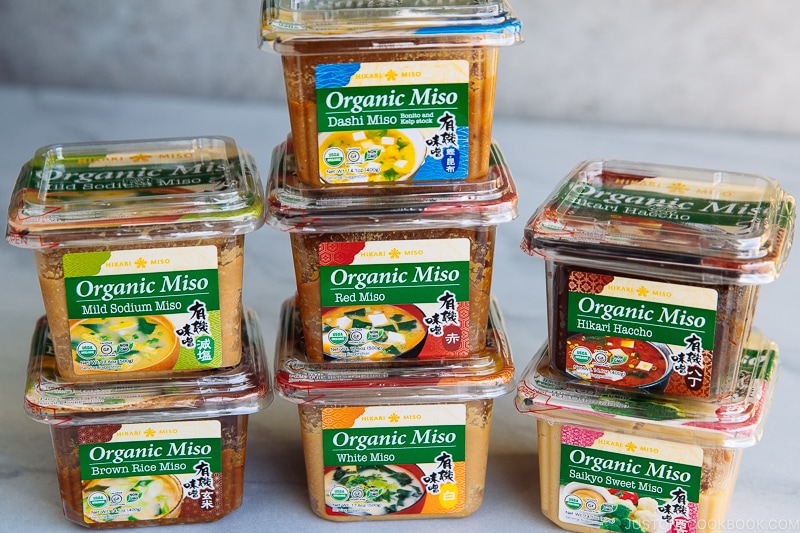
The nutty flavor and savoriness of the sauce go terrifically well with vegetables. The key is to lightly dip the steamed vegetables into the sauce, without overcoating them. You want to enjoy the natural sweetness of the vegetables and the sauce is to enhance the eating pleasure.

Additional Tips to Make Perfectly Steamed Vegetables
1. Use a large pot with the lid
It’s always better to use a bigger pot where steam can go around the vegetables.
2. Add 1-2 cups of water
You’ll need at least 1 inch deep of water, just enough to steam the vegetables. You can use the leftover water for cooking. In fact, we use dashi (Japanese soup stock) to create dashi-infused steam to cook the vegetables in this recipe.
3. Add vegetables after boiling
It’s important to add the vegetables after the water is completely boiling. If you add the vegetables while the water has yet to boil, the newly created steam will turn back into water droplets when it touches cold vegetables. As a result, vegetables will get more watery. Therefore, add the vegetables when there is plenty of steam coming out from the steamer.
4. Keep on medium-high heat
You want to make sure lots of steam is continuously being created, and your heat setting should be on medium-high. When you add the vegetables, the temperature will drop quickly, so keep the heat on high for 2-3 minutes first.
5. Use a bamboo skewer to check doneness
Don’t rely on the cooking time so much. Even with the same vegetables, steaming time can be different based on how you cut the vegetables. The best way is to use a bamboo skewer and see if it goes through.

How to Steam Vegetables without a Steamer
The most common way to steam vegetables is by using a pot with a good fitting lid and a metal steamer basket. What if you don’t have a steamer? Don’t worry! You can still enjoy this steamed vegetable recipe without it. Here’s a fantastic hack I learned from a friend:
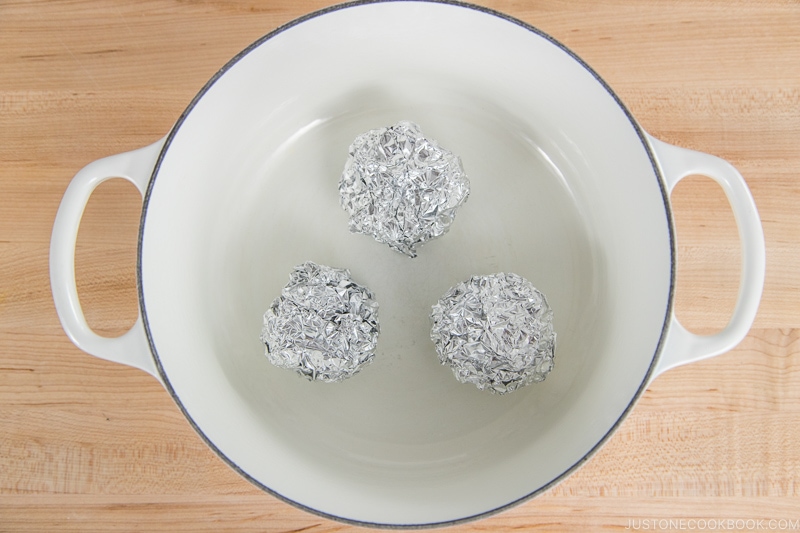


My Donabe Steamer

I purchased this donabe steamer at Toiro Kitchen & Supply in Los Angeles. The owner Naomi-san has a beautiful online shop where they ship worldwide.
Steamed vegetables are great all year round, but it’s more fun to serve at a table with a portable stovetop, especially in fall and wintertime. Colorful, bright, and extremely nutritious, they are what good eating is about. And don’t forget to enjoy the vegetables with the lip-smacking miso sesame sauce!
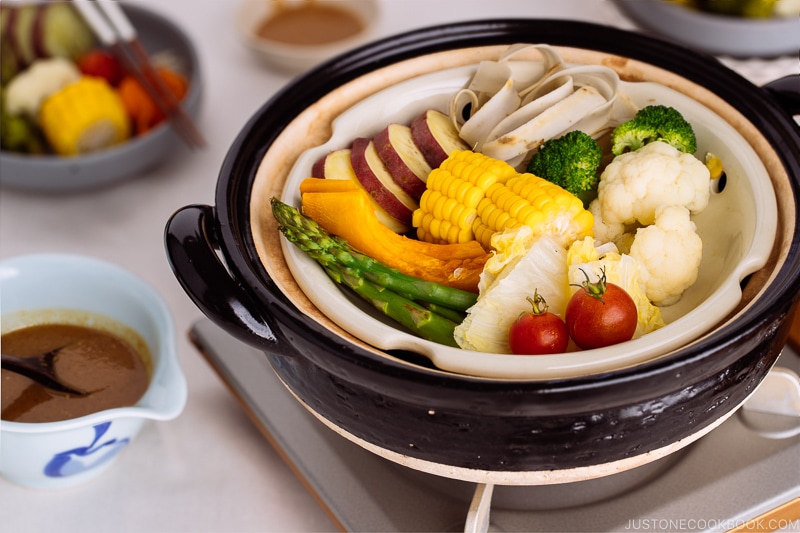
Wish to learn more about Japanese cooking? Sign up for our free newsletter to receive cooking tips & recipe updates! And stay in touch with me on Facebook, Pinterest, YouTube, and Instagram.

Steamed Vegetables with Miso Sesame Sauce (Mushi Nabe)
Ingredients
For the Miso Sesame Sauce
- 6 Tbsp toasted white sesame seeds
- 2 cloves garlic
- 1 tsp sugar
- 2 Tbsp miso
- 2 Tbsp soy sauce
- 2 Tbsp toasted sesame oil
- 4 Tbsp mirin
- 2 Tbsp rice vinegar (unseasoned)
- ¼ tsp Diamond Crystal kosher salt
For Steaming
- 2 cups dashi (Japanese soup stock) (use standard Awase Dashi, dashi packet or powder, or Vegan Dashi; or substitute water)
For the Vegetables (customize as you like)
- 1 Japanese sweet potato (Satsumaimo)
- ½ gobo (burdock root)
- ¼ kabocha squash
- 1 carrot
- 1 ear sweet corn
- 10 asparagus spears
- 1 head broccoli
- 1 head cauliflower
- 5 leaves napa cabbage
- 10 cherry tomatoes
Instructions
To Prepare the Miso Sesame Sauce
- Gather all the ingredients for the Miso Sesame Sauce.

- Grind 6 Tbsp toasted white sesame seeds with a pestle and mortar.

- Crush 2 cloves garlic. Add 1 tsp sugar and 2 Tbsp miso and combine well.

- Add 2 Tbsp soy sauce, 2 Tbsp toasted sesame oil, 4 Tbsp mirin, and 2 Tbsp rice vinegar (unseasoned). Mix well.

- Check the taste and add kosher salt, if necessary. I added ¼ tsp Diamond Crystal kosher salt.
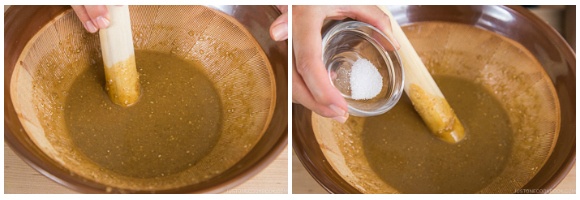
To Prepare the Vegetables
- Prepare all the ingredients. Make 2 cups dashi (Japanese soup stock); otherwise, use water instead.

- Cut 1 Japanese sweet potato (Satsumaimo) into ¼-inch (6-mm) slices (uniform, smaller pieces will cook faster than larger pieces). Soak in water to remove the starch. Drain and set aside.

- Wash ½ gobo (burdock root) really well and peel it thinly with a peeler. Soak in water immediately to keep it from changing color; after a few minutes, change the water once and soak again. Drain and set aside.

- Discard the seeds from ¼ kabocha squash and slice thinly.

- You can either cut 1 carrot into ¼-inch (6-mm) slices or use a peeler to peel the carrot.

- Cut 1 ear sweet corn into pieces 1 inch (2.5 cm) thick.

- Hold each of the 10 asparagus spears and snap and discard the shorter bottom end. Cut the asparagus in half lengthwise.

- Cut 1 head broccoli and 1 head cauliflower into florets.
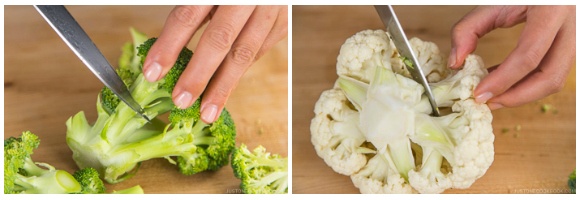
- Cut 5 leaves napa cabbage into bite-size pieces.

To Steam
- Pour the dashi in your steamer pot, cover the lid, and bring it to boil on medium-high heat. Make sure you have at least 1–2 inches of dashi or water in your steamer or pot. Insert the steamer basket. Check that the surface of the dashi (or water) is not touching the basket. If it is, then remove some of the liquid.

- When steam is coming out from the pot strongly, reduce the heat to medium and place in the steamer basket the hard vegetables, such as the sweet potatoes and root vegetables. I also added kabocha squash and corn here as the rest of ingredients are fairly fast to cook. Cover the pot and set timer for 5 minutes.

- Then, add the “flowering” vegetables such as asparagus, broccoli, and cauliflower. Add the bottom part of the napa cabbage at this time. I also added the carrot ribbons here. Set the timer for 3 minutes.
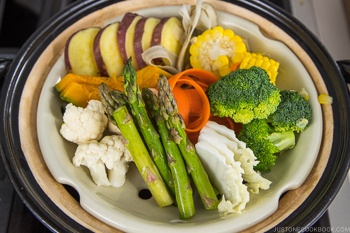
- Lastly, add the leafy part of the napa cabbage and 10 cherry tomatoes. Cook for 2 more minutes.

- Insert a bamboo skewer to check the doneness of the denser vegetables. If it goes through, it’s ready to eat! Stop the steaming when the vegetables are still a bit crunchy since the residual heat will continue to cook the vegetables.

- Serve the steamed vegetables with Miso Sesame Sauce and enjoy! During the meal, you can continue to steam the vegetables. Keep an eye on the dashi/water inside the pot. Make sure you are not running out of dashi/water. If it’s too little, add more dashi/water.









Hi! I’m gonna try this tomorrow, can I use the remaining dashi after steaming the veggies with it?
Hi, Yannic! Thank you for trying Nami’s recipe.
Yes, however, it depends on the veggies you use; the flavor and taste will differ, so please taste it first before using the remainder of the dashi. We hope this helps!
Awesome, thanks for the quick response!
My pleasure!😃
This is great. I made different veggies because I’m on a 90% cruciferous diet (cabbage, spinach, broccoli, broccoil stems, cauliflower) and added some thin carrots, red onion, and mushroom. The sauce was delicious–even without the sesame oil, which is also a no-no for me. Also, I used a tsp of date syrup instead of the sugar. When I have the opportunity I’ll make it with the sweet potatoes as well. So very good. Thanks a million.
Hi Beth! We are so happy to hear you enjoyed Nami’s recipe!
Thank you so much for sharing your experience with us.
Happy Cooking!
Will steaming with stock instead of water make a difference to the taste of the veg?
Hi Soo, Thank you so much for reading Nami’s post and trying her recipe.
The flavor from stock would taste in the veggie, and you may notice the difference. But water would work too.
We hope this helps!
What should be the texture of the sesame seeds once ground? I only have a coffee grinder so not sure if they should be powder form or more like a paste
Hi Tanuja, The sesame seed can ground up to Powderly or leave some texture if you prefer.
We hope this helps!
Thank you, Naomi! Sorry one more question – is there anything I can use to substitute the mirin?
Hi Tanuja! You are welcome!
To substitute the Mirin, you can use sake/water + sugar.
The ratio of sake/water and sugar should be 3 to 1. For example, for 1 Tbsp (or=3 tsp) sake/water, mix with 1 tsp of granulated sugar. Another alternative is to mix chicken broth with sugar. We hope this helps!
Could I use your sake/water + sugar substitute instead of the mirin for this? Love all your recipes so far!
Hi Tanuja! Yes, you can use sake/water + sugar instead of mirin.
The ratio of sake/water and sugar should be 3 to 1. For example, for 1 Tbsp (or=3 tsp) sake/water, mix with 1 tsp of granulated sugar. Another alternative is to mix chicken broth with sugar. We hope this helps!
Hi Nami!
This looks like such a simple yet delicious meal! Sometimes simplicity is the best way to enjoy food’s natural flavors 🙂
Are you using the medium or large mushi nabe? I’m thinking about getting one!
Sarah
Hi Sarah! Yeah, it’s easy and simple, and as you said, when ingredients are good, it tastes amazing as it is! This mushi nabe is… I think medium??
We love this sauce, and the tips on steaming the veggies are so useful (even though I’ve been steaming veggies for decades)! I’m wondering whether you think it would work to use a tablespoon or two of tahini instead of pulverizing the sesame seeds? We don’t have a suribachi, and I can’t get a good paste from the sesame seeds with our smooth mortar and pestle. I would appreciate any thoughts you might have on this. Thank you!
Hi Virginia! Thank you for your kind words. Well, you “can”. But the tahini paste is different from when you grind your sesame seeds (see the right image of Step 2). The taste is slightly different too, but if you want to substitute, that’s the closest thing. The texture of ground sesame seeds is nice in the sauce too. You can put the sesame seeds in the bag and use a rolling pin to roll or pound too. I would say tahini and ground sesame seeds are kind of different, although they are both made from sesame seeds… So I would not substitute. 🙂
Nami, this is delicious. I am starting to think maybe this is a recipe where I can use the dashi pouches I bought on clearance at the Asian grocery store, since the dashi flavor steamed into the veggies is subtle. I spent too much time making real ichiban and niban dashi today. Lol.
I really love this dish as a way to eat many veggies and to make them easily and quickly, especially since these will stay good in the fridge for several days and can go with basically any meal. I had to try it with all of the veggies this time to find out which ones I really like the most. The sweet potato was probably my favorite because the sweetness pairs well with the salty sauce, but I LOVED all of the veggies (except the cauliflower, which I just liked, haha). I accidentally threw away the leftover gobo from New Year’s so I didn’t get to use it in this. D: But I had some snow peas and threw those in for the last couple minutes and they were great!
Hi Lion! I’m so happy to hear you enjoyed this recipe! We love this dish a lot, especially fall/winter time as I just keep the donabe in the middle to cook the veggies while we eat the other food. 🙂
Yeah, dashi pouch is perfect for this – since the dashi is not direct taste (like in soup), it’s just the steam if you don’t use the leftover dashi – you will need to keep adding water if you steam a lot of food.
My favorite is also satsumaimo too. I take up 1/3 of space for MY satsumaimo. LOL. Gobo is delicious, as it goes well with sesame seed/miso sauce.
Thank you for trying this recipe!